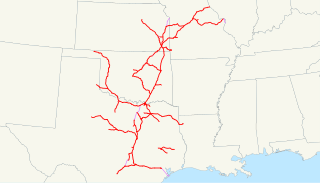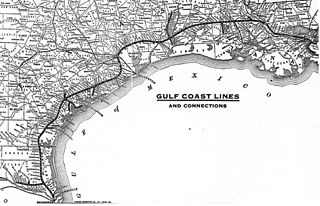Related Research Articles

Cass County is a county located in the western part of the U.S. state of Missouri and is part of the Kansas City metropolitan area. As of the 2020 census, the population was 107,824. Its county seat is Harrisonville; however, the county contains a portion of Kansas City, Missouri. The county was organized in 1835 as Van Buren County, but was renamed in 1849 after U.S. Senator Lewis Cass of Michigan, who later became a presidential candidate.

The Missouri–Kansas–Texas Railroad was a Class I railroad company in the United States, with its last headquarters in Dallas, Texas. Established in 1865 under the name Union Pacific Railroad (UP), Southern Branch, it came to serve an extensive rail network in Texas, Oklahoma, Kansas, and Missouri. In 1988, it merged with the Missouri Pacific Railroad; today, it is part of UP.

The Missouri Pacific Railroad, commonly abbreviated as MoPac, was one of the first railroads in the United States west of the Mississippi River. MoPac was a Class I railroad growing from dozens of predecessors and mergers. In 1967, the railroad operated 9,041 miles of road and 13,318 miles of track, not including DK&S, NO&LC, T&P, and its subsidiaries C&EI and Missouri-Illinois.

The Alabama & Gulf Coast Railway is a Class II railroad owned by Genesee & Wyoming. It operates 339 miles (546 km) of track from the Pensacola, Florida export terminals, west of downtown, north to Columbus, Mississippi, with trackage rights along BNSF Railway to Amory, Mississippi. A branch uses trackage rights along Norfolk Southern from Kimbrough, Alabama west and south to Mobile, Alabama, with separate trackage at the end of the line in Mobile.

The St. Louis–San Francisco Railway, commonly known as the "Frisco", was a railroad that operated in the Midwest and South Central United States from 1876 to November 21, 1980. At the end of 1970, it operated 4,547 miles (7,318 km) of road on 6,574 miles (10,580 km) of track, not including subsidiaries Quanah, Acme and Pacific Railway and the Alabama, Tennessee and Northern Railroad; that year, it reported 12,795 million ton-miles of revenue freight and no passengers. It was purchased and absorbed into the Burlington Northern Railroad in 1980. Despite its name, it never came close to San Francisco.

The Kansas City, Memphis & Birmingham Railroad is a historic railroad that operated in the southern United States.

The St. Louis Southwestern Railway Company, known by its nickname of "The Cotton Belt Route" or simply "Cotton Belt", was a Class I railroad that operated between St. Louis, Missouri, and various points in the U.S. states of Arkansas, Tennessee, Louisiana, and Texas from 1891 to 1980, when the system added the Rock Island's Golden State Route and operations in Kansas, Oklahoma, and New Mexico. The Cotton Belt operated as a Southern Pacific subsidiary from 1932 until 1992, when its operation was assumed by Southern Pacific Transportation Company.

The Missouri & Northern Arkansas Railroad, LLC is a Class II Regional Railroad in the U.S. states of Missouri, Kansas, and Arkansas. The company is headquartered in Carthage, Missouri. It is not to be confused with the Missouri and North Arkansas Railroad which connected Joplin, Missouri, with Helena, Arkansas, from 1906 to 1946.
The Fort Smith and Western Railway was a railroad that operated in the states of Arkansas and Oklahoma.

The Panhandle and Santa Fe Railway (P&SF) was a railroad company that was a subsidiary of the Atchison, Topeka and Santa Fe Railway (AT&SF), operating primarily in the Texas Panhandle.
The Choctaw, Oklahoma and Gulf Railroad (CO&G), known informally as the "Choctaw Route," was an American railroad in the states of Arkansas and Oklahoma.
The Belton, Grandview and Kansas City Railroad (SHRX) is short line passenger railroad and museum located in Belton, Missouri. It operates as a heritage railroad, on what was once the St. Louis and San Francisco Railway (Frisco), on the Kansas City to Springfield branch. With the merger of the Frisco with the Burlington Northern, the line was partially sold to the Kansas City Southern Railway north of 155th Street. The north of the line is used once a year when tree trimming/weed spraying takes place, and the tracks are bad though can still can be used. The bridge is still there past Markey Road but with missing ties, while the southernmost portion from Peculiar, MO. to Clinton, MO. has been scrapped and abandoned. This left the remaining trackage of a few miles connecting Grandview and Belton, Missouri. The railroad currently operates a 1952 GM GP 9 locomotive, which is used to pull an excursion train. Also included in the railroad's collection are various locomotives, cars and equipment.

The Gulf Coast Lines was the name of a railroad system comprising three principal railroads, as well as some smaller ones, that stretched from New Orleans, Louisiana, via Baton Rouge and Houston to Brownsville, Texas. Originally chartered as subsidiaries of the Frisco Railroad, the system became independent in 1916 and was purchased by the Missouri Pacific Railroad in 1925.
The Okmulgee Northern Railway Company (ON), originally the Coalton Railway, was a shortline rail carrier in Okmulgee County, Oklahoma. It was in operation from 1916 to 1964.
The Miami Mineral Belt Railroad (MMBR) served the Miami and Picher lead mining areas in that portion of the Tri-state mining district located in far northeastern Oklahoma. It was closely associated with the St. Louis-San Francisco Railway (Frisco) for its entire history, and was eventually absorbed into the Frisco.
The Missouri and Western Railway (M&WR) completed a main line from Pierce City, Missouri through Sacoxie and Joplin, Missouri to Oswego, Kansas, with a branch line north from Joplin to Oronogo, Missouri, with a total length of 83.23 miles. The trackage was finished in 1879, and the company was purchased by the St. Louis-San Francisco Railway (Frisco) the same year.
The Kansas and Arkansas Valley Railway (“K&AV”) was owner of 170.64 miles of single track, standard gauge steam railroad line, consisting of a 164.63 mile mainline from a junction near Van Buren, Arkansas through Oklahoma to Coffeyville, Kansas, with branch lines of 6.01 miles. It began operations in 1888 and sold its property to the St. Louis, Iron Mountain and Southern Railway in 1909.
The St. Louis, San Francisco and New Orleans Railroad ran from Hope, Arkansas to a point near Ardmore, Oklahoma, and encompassed about 219 miles of track including a branch line. It existed from 1895 to 1907, when its assets were taken over by the St. Louis-San Francisco Railway (“Frisco”).
The Kansas City, Fort Scott and Memphis Railroad (“KCFS&M”) was a railway system which, at its maximum extent, operated across Kansas, Missouri, Arkansas, Tennessee, Mississippi, Alabama and Oklahoma, a total of over 881 miles. Its predecessor company started in 1865, and another railroad assumed ownership in 1928.
References
- ↑ "Corporate History Kansas City, Fort Scott & Memphis Railroad Company". Truman Area Community Network. June 2, 2008. Archived from the original on July 18, 2012. Retrieved February 12, 2009.
- 1 2 3 4 5 6 7 8 9 10 11 "Valuation Docket No. 400, St. Louis-San Francisco Railway Company et al., decided July 8, 1932". Interstate Commerce Commission, July 8, 1932, pp. 139, 717-747. Retrieved April 7, 2024.
- 1 2 3 4 "Line in Detail". Belton, Grandview & Kansas City Railroad. Retrieved April 8, 2024.
- ↑ "The Kansas City, Fort Scott and Gulf Railroad". Legends of Kansas. Retrieved March 28, 2024.
- The Historical Guide to North American Railroads, 2nd Edition, Kalmbach Books.
- History of the Leaky Roof Railway
- Map of the KCC&S and KCOS&S